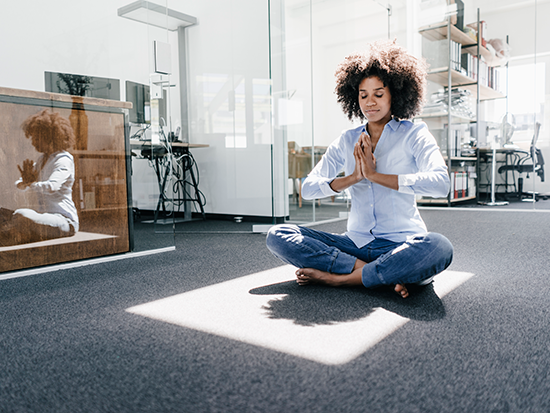Media contact: Brianna Hoge
 After months of working remotely during the COVID-19 pandemic, many employees now find themselves back in the office. But just because one may work behind a desk does not mean they need to be sedentary.
After months of working remotely during the COVID-19 pandemic, many employees now find themselves back in the office. But just because one may work behind a desk does not mean they need to be sedentary.
Five University of Alabama at Birmingham experts provide ways to increase activity levels throughout the workday.
Start small
The Centers for Disease Control and Prevention recommends that adults get 150 minutes of physical activity each week.
“This can be daunting,” noted Elena Kidd, program manager in the UAB Office of Public Health Practice. So, what are some ways to get started?
“Time is really a common barrier that many of our employees face — or more specifically, lack thereof,” said Riley Thornton, UAB Employee Wellness manager. “I generally encourage employees to start small by getting maybe 10 to 15 minutes of activity at a time perhaps a couple of times a day.”
Thornton suggests walking around the building on a nice day, walking to get lunch, or walking to the car instead of taking a bus or shuttle.
As a personal trainer and coordinator of fitness at UAB University Recreation, Pedro Magalhaes recommends that time-crunched clients tackle that 150-minute recommendation in manageable chunks.
“I break it down as five days a week, 30 minutes a day — and you don’t get those 30 minutes in straight,” he said. “If you have a dog, walk your dog for 10 minutes in the morning, 10 minutes in the afternoon and 10 minutes in the evening. That’s 30 minutes right there.”
Gather a crew
Olivia Affuso, Ph.D., associate professor in the School of Public Health, says it is far easier to engage in activities when there is someone to go along.
“One thing an individual might do is find someone else in their department to go for a quick walk with,” she said. “Some of my research shows that the networks of individuals we have to draw from can include our co-workers or anyone in our more immediate environment.”
What if there are not any exercise-minded colleagues? Try out a group fitness class at a gym.
Plan to succeed
Another benefit of “having a group or a community to engage with” is that “you can have that built-in accountability for each other,” Affuso said.
“It’s amazing when you have a goal, and you have support, how you can start small and build up over time,” she said. “For instance, I run every day, and I have people who will ask me ‘Did you run today?’ Of course, I don’t want to let them down, and I also don’t want to let myself down.”
Even as an individual, “this could look like sending a calendar invitation to yourself for 10 to 15 minutes of activity in between meetings,” Thornton said. “Whether that’s standing at your desk or taking a lap around your office floor, walking around your building or doing some standing desk stretches. Personally, I have found that, on days when I bring my tennis shoes to the office, I’m more likely to get out for a lunchtime stroll.”
Try a walking meeting
Kristi Menear, Ph.D., professor in the Department of Human Studies at the UAB School of Education, started leading walking meetings in her department in fall 2019. Menear says her walking meetings are either one-on-ones or small-group meetings, with a maximum of four people, so the group stays together and can make eye contact.
“Where we walk is personal preference each time and depends on factors such as attire, shoes, weather, need for confidentiality and how long the meeting will last,” Menear said.
Menear gives the following advice for anyone looking to start a walking meeting:
- Plan ahead. “Discuss ‘walking meeting’ when the location of the meeting is being determined. That way, everyone is prepared — bringing their walking shoes, for instance.”
- Will it work on the go? “Walking meetings work best when the purpose of the meeting is discussion and people will not need to use electronic devices or read paper during the meetings.”
- Need new ideas? Go for a walk. “We have found that the movement, change of scenery and level of engagement during the walking meetings all lead to a lot of idea generation. Be prepared to take notes during the meeting, which can be done on a smartphone or small paper notebook.”
- Give it a try. “Try a spontaneous walking meeting when you stop to chat with someone you just ran into. Walk for five minutes together and catch up with each other while you are walking.”
- Set a goal. Keep the practice going by “setting a goal for yourself to have a minimum number of walking meetings over a given period of time.”